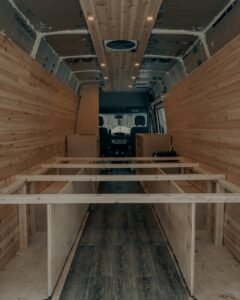Figuring out how to power your van and manage fresh water and waste can feel daunting.
The good news is, creating a comfortable and functional electrical and plumbing system for your van is within reach! This guide will be your one-stop shop for understanding the essentials of van electrical and plumbing. We’ll break down the key components, explain how they work together, and even explore DIY options to get you started on building your dream mobile home.
Imagine waking up to a steaming cup of coffee brewed with your own van’s electrical system and being able to wash your dishes. With a solid grasp of van electrical and plumbing, you can turn your van into a self-sufficient haven, free to roam wherever your wanderlust takes you.
I personally like to keep my camper van electrical and plumbing as simple as possible. I use a portable Bluetti battery to power everything and a 100w solar panel or two to keep everything charged. What’s cool about the Bluetti battery is that you can also charge it with your 12V port in your van while driving if the weather isn’t favourable. You can also bring it pretty much everywhere with you which isn’t the case a marine battery or any other sort of permanent installation (also, if those catch fire, there’s no way of saving the van). Lastly, I keep plumbing to the sink with a freshwater tank and grey water tank (both Reliance jugs) and a galley pump to get water to the sink. Need hot water? I use a tea kettle. Need to shower? Get a gym membership.
Why permanent marine batteries are a bad idea
Forget the bulky marine batteries under your bed! While tempting for their deep discharge capabilities, they pose a serious safety hazard. Marine batteries are notorious for catching fire, especially if improperly maintained or ventilated. Imagine a fire erupting right where you sleep! The worst part? These batteries are often bolted down and inaccessible from inside the van. Grabbing and tossing them out during an emergency is nearly impossible. Plus, their fixed placement means they’re stuck in the van, unlike portable options you can use for powering other things around your campsite. Let’s explore safer and more versatile alternatives for keeping your van life adventures worry-free.
The advantage of portable power stations (Bluetti, Jackery, etc…)
Ditch the fire risk and embrace the freedom of portable power stations! Unlike bulky marine batteries, these sleek units offer unmatched safety and versatility.
Imagine a scenario: a malfunction sparks a fire in your portable station. Unlike its under-bed counterpart, you can easily grab it and toss it out, saving your van and your peace of mind. Plus, portability is a game-changer. Need to power a picnic table blender or campsite lights? Simply grab your portable station and head outside. They’re not just for your van!
These powerhouses also offer convenient charging options. Top them up while you drive using your van’s 12V port, or harness the sun’s power with a solar panel. Gone are the days of relying solely on campsites with hookups. Portable stations empower you to explore freely, with the confidence of reliable off-grid power.
How to install a solar panel on your van
Portable power stations are fantastic, but why not extend their life with the ultimate renewable energy source – the sun! Adding a solar panel to your van roof is easier than you might think.
Here’s a quick rundown:
- Choose Your Panel: Select a solar panel that aligns with your power needs and roof space. Many pre-made kits come with mounting brackets and cables.
- Measure and Mark: Carefully measure your roof to determine the optimal placement for the panel. Remember to account for airflow and avoid shading from vents or other features. Mark the mounting points with a pencil.
- Drill and Secure: Using appropriate drill bits and safety gear, carefully drill pilot holes at the marked points. Here’s where a little extra protection comes in! Apply a thin bead of silicone sealant around each hole before securing the mounting brackets with appropriate fasteners, ensuring compatibility with your van’s roof material. Finish by painting any exposed metal with a rust-oleum product to prevent corrosion.
- Run the Cable: With the panel secured, route the cable from the panel down to the location where you’ll store your portable power station. Use designated cable channels or clips to keep the cable safe and organized. Most kits come with pre-made cables with connectors specifically designed for your portable station.
Pro Tip! Consult a professional for assistance if you’re unsure about drilling into your van’s roof. They can ensure proper installation and avoid any potential leaks.
By adding a solar panel and taking these extra precautions, you’ll be maximizing your portable power station’s potential, reducing reliance on external charging sources, and embracing the freedom of truly off-grid van life!
Why having a shower in your van is a bad idea
The allure of a built-in van shower is undeniable, but before you carve out precious space, consider the downsides. Moisture is the enemy in a van! Enclosed showers trap humidity, creating a breeding ground for mold and mildew. Imagine climbing into a damp, smelly van – not exactly the picture of relaxation! Constant ventilation is crucial, adding complexity to your electrical system. Plus, where will all that shower water go? Installing a grey water tank adds weight, maintenance, and potential leaks.
Here’s a simpler solution: embrace the “gym life.” National gym memberships are surprisingly affordable, offering showers and other amenities across the country. No more wrestling with limited van space or battling moisture monsters.
Not a gym fan? Exterior showers seem tempting, but practicality often gets sacrificed. Finding a secluded spot to use one can be tricky, and legal restrictions might apply in some areas. Plus, wild swimming isn’t always an option, depending on climate and location.
The secret weapon? Your trusty sink! A good washcloth and some ingenuity go a long way. For hot water, a portable electric kettle is a lifesaver. Not only is it space-efficient, but it avoids the need for a complex heater system in your van.
Remember, van life is about freedom and exploration, not replicating your entire home on wheels. By adopting a minimalist approach to hygiene, you’ll gain valuable space for the things that truly matter – like that surfboard or extra gear for your next adventure!
Installing fresh and grey water tanks
Forget complex plumbing installations! This clever setup utilizes readily available Reliance jugs for your fresh and grey water needs. Here’s how to create a basic yet functional system:
- Gather Your Supplies: You’ll need two Reliance jugs (one for fresh, one for greywater), a galley pump, a faucet, some food-grade tubing, hose clamps, and a drill with appropriate bits.
- Tank Placement: Choose a location under your sink to house both jugs. Consider stability and ease of access when filling and emptying.
- Drill for the Faucet: Carefully drill a hole in your sink for the faucet, ensuring a snug fit. Install the faucet according to the manufacturer’s instructions.
- Fresh Water Connection: Attach one end of your food-grade tubing to the pump inlet, and the other end to the fresh water jug. Use hose clamps to secure all connections for leak prevention.
- Pump Installation: Mount the galley pump according to the manufacturer’s instructions, ensuring it’s secure and accessible for filling.
- Grey Water Drainage: Attach tubing to the pump outlet and run it to your grey water jug. Again, secure all connections with hose clamps. Consider adding a shut-off valve near the jug for easy emptying.
- Connect the Faucet: Run a separate piece of tubing from the pump outlet to the faucet. Secure the connection and test the pump to ensure smooth water flow.
There you have it! A simple and affordable way to manage your van’s water needs. Remember to label your jugs clearly (fresh vs. grey) and sanitize them regularly to prevent bacteria growth.
Bonus Tip! For added convenience, consider adding a small inline filter to your fresh water line for cleaner drinking water.
Summary
Congratulations! You’ve taken a giant leap towards van life freedom by ditching bulky marine batteries and embracing the safety and versatility of portable power stations. We explored the ease of harnessing the sun’s power with solar panels, and you learned why a gym membership might be a better solution than a cramped van shower. Finally, we tackled the surprisingly simple world of van plumbing with readily available Reliance jugs.
This is just the beginning of your van life journey! Here’s how to keep the adventure rolling:
- Dive deeper into Week 11: Heating, Cooling & Ventilation Strategies! (This creates intrigue for the next blog post) Stay comfortable year-round with clever solutions for keeping your van cool in the summer and warm in the winter.
- Don’t miss last week’s post (Week 9): Essential Van Cabinetry Tips! (Highlights the value of the previous post) Learn how to design and build functional cabinets to maximize your van’s storage space and create a clutter-free living area.
- Join the thriving DIY Camper Build community! (Clear call to action for reader engagement) Connect with other DIY vanlifers, share your adventures, and get expert advice to help you conquer every step of the build.
So, buckle up and get ready to conquer van life, one simple system at a time!





